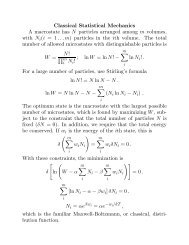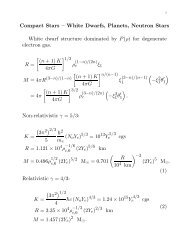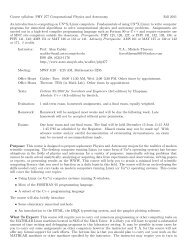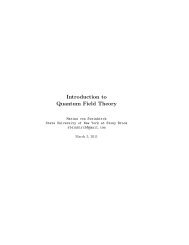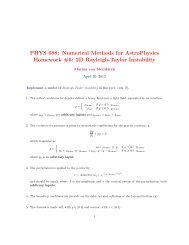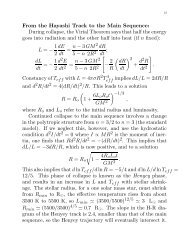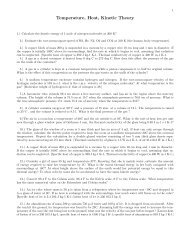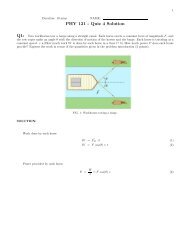how to get started in Linux with the Microsoft Kinect - Stony Brook ...
how to get started in Linux with the Microsoft Kinect - Stony Brook ...
how to get started in Linux with the Microsoft Kinect - Stony Brook ...
Create successful ePaper yourself
Turn your PDF publications into a flip-book with our unique Google optimized e-Paper software.
Introduction <strong>to</strong> <strong>the</strong> <strong>Microsoft</strong> K<strong>in</strong>ect for<br />
Computational Pho<strong>to</strong>graphy and Vision<br />
Mar<strong>in</strong>a von Ste<strong>in</strong>kirch, ste<strong>in</strong>kirch@gmail.com<br />
State University of New York at S<strong>to</strong>ny <strong>Brook</strong><br />
May 9, 2013<br />
Abstract<br />
We <strong>in</strong>troduce <strong>the</strong> depth sensor <strong>Microsoft</strong> K<strong>in</strong>ect and<br />
s<strong>how</strong> <strong>how</strong> <strong>to</strong> start its use for develop<strong>in</strong>g applications<br />
on L<strong>in</strong>ux. We discuss <strong>the</strong> options for frameworks and<br />
drivers and s<strong>how</strong> an (orig<strong>in</strong>al) <strong>in</strong>stallation tu<strong>to</strong>rial<br />
on Fedora. F<strong>in</strong>ally, we expla<strong>in</strong> <strong>the</strong> calibration and<br />
we <strong>in</strong>troduce <strong>to</strong>ols <strong>to</strong> manipulate <strong>the</strong> depth data us<strong>in</strong>g<br />
po<strong>in</strong>t clouds.<br />
Introduc<strong>in</strong>g <strong>the</strong> K<strong>in</strong>ect<br />
<strong>Microsoft</strong> released <strong>the</strong> K<strong>in</strong>ect for Xbox 360 <strong>in</strong>putdevice<br />
<strong>in</strong> November of 2010, as <strong>the</strong> first large-scale,<br />
commercial release of a depth camera device(a<br />
camera that can see <strong>in</strong> 3D!). A very similar sensor,<br />
now specific for develop<strong>in</strong>g, <strong>the</strong> K<strong>in</strong>ect for W<strong>in</strong>dows,<br />
was released <strong>in</strong> February of 2012. These sensor come<br />
<strong>with</strong> a proprietary algorithms for feature selection,<br />
scene analysis, motion track<strong>in</strong>g, skeletal track<strong>in</strong>g,<br />
and gesture recognition [1]. In addition, <strong>the</strong><br />
company that developed <strong>the</strong>, <strong>the</strong> PrimeSense Ltd.<br />
[2], has also released ano<strong>the</strong>r sensor <strong>with</strong> <strong>the</strong> similar<br />
technology, <strong>the</strong> ASUS Xtion [3].<br />
Depth Sens<strong>in</strong>g<br />
The depth sens<strong>in</strong>g works <strong>with</strong> <strong>the</strong> pr<strong>in</strong>ciple of structured<br />
light 1 . The system consists of two parts, <strong>the</strong><br />
1 Process of project<strong>in</strong>g a known pattern of pixels on <strong>to</strong> a<br />
scene look<strong>in</strong>g <strong>to</strong> <strong>the</strong> way <strong>the</strong>y deform when meet<strong>in</strong>g surfaces,<br />
which allows vision systems <strong>to</strong> calculate <strong>the</strong> depth and surface<br />
<strong>in</strong>formation of <strong>the</strong> objects.<br />
Figure 1: The K<strong>in</strong>ect hardware (Xbox model).<br />
IR laser emitter and <strong>the</strong> IR camera. The emitter<br />
creates a known noisy pattern of structure IR light at<br />
830 nm [4]. The output of <strong>the</strong> emitter has a pattern<br />
of n<strong>in</strong>e bright dots, caused by <strong>the</strong> imperfect filter<strong>in</strong>g<br />
of light 2 . The dots are recorded by <strong>the</strong> IR camera<br />
and <strong>the</strong>n compared <strong>to</strong> a know pattern, where any<br />
disturbances are <strong>to</strong> be <strong>the</strong> variations <strong>in</strong> <strong>the</strong> surface,<br />
detected as closer or fur<strong>the</strong>r away. The field of view i<br />
s 58 o horizontal and 45 o vertical, and <strong>the</strong> operational<br />
range is between 0.8 <strong>to</strong> 3.5 meters. The sensor has<br />
roughly 1 cm depth (z) resolution.<br />
Color pixels are made of different amounts of red,<br />
green, and blue, while greyscale images are a s<strong>in</strong>gle<br />
value represent<strong>in</strong>g brightness of that pixel. The<br />
K<strong>in</strong>ect provides a color image from its RGB camera<br />
and grey-scale image from its depth camera. Both<br />
images have a resolution of 640x480 and both cameras<br />
operates at a (max) of 30 fps.<br />
2 This scatter<strong>in</strong>g <strong>in</strong>novation, allow<strong>in</strong>g a higher powered laser<br />
diode <strong>to</strong> be used and be<strong>in</strong>g eye safe was developed by Prime-<br />
Sense, which has a patent on this process.<br />
1
Available Framework and Drivers<br />
Up <strong>to</strong> <strong>the</strong> date, <strong>the</strong>re are two platforms for <strong>the</strong> K<strong>in</strong>ect<br />
sensor available for L<strong>in</strong>ux 3 :<br />
OpenNI (Open Natural Interaction) [6]:<br />
A middleware delivered from a collaboration<br />
of PrimeSense <strong>to</strong> develop “natural <strong>in</strong>teraction”<br />
software and devices. It has skeletal track<strong>in</strong>g<br />
and gesture recognition. However, <strong>the</strong> OpenNI’s<br />
features on user track<strong>in</strong>g (<strong>in</strong> which an algorithm<br />
processes <strong>the</strong> depth image <strong>to</strong> determ<strong>in</strong>e <strong>the</strong> position<br />
of all of <strong>the</strong> jo<strong>in</strong>ts of any users <strong>with</strong><strong>in</strong> <strong>the</strong><br />
camera’s range) is not covered by <strong>the</strong> OpenNI<br />
LGPL license. Instead, it is provided by an external<br />
module, called NITE which is not available<br />
under an open source license.<br />
OpenK<strong>in</strong>ect [7]:<br />
This driver is known by its library name<br />
libfreenect and was <strong>the</strong> first K<strong>in</strong>ect driver available<br />
for general use and is fully open-source (dual<br />
Apache 2.0/GPL 2.0 license), cross-platform,<br />
and derived purely from reverse-eng<strong>in</strong>eer<strong>in</strong>g efforts.<br />
libfreenect implements low-level access <strong>to</strong><br />
<strong>the</strong> hardware by directly communicat<strong>in</strong>g <strong>with</strong><br />
<strong>the</strong> K<strong>in</strong>ect’s USB endpo<strong>in</strong>ts.<br />
The OpenK<strong>in</strong>ect driver was chosen for this project<br />
based upon its simple software <strong>in</strong>terface, low-level<br />
hardware access, cross-platform support, and support<br />
for multiple languages. In addition, libfreenect has<br />
<strong>the</strong> ability <strong>to</strong> retrieve uncalibrated depth images from<br />
<strong>the</strong> K<strong>in</strong>ect, for <strong>the</strong> depth calibration.<br />
Install<strong>in</strong>g <strong>the</strong> K<strong>in</strong>ect<br />
Hardware Requirement<br />
All you need <strong>to</strong> <strong>in</strong>stall <strong>the</strong> K<strong>in</strong>ect <strong>to</strong> your computer is<br />
a USB 2.0 hub (K<strong>in</strong>ect will take 70% of it <strong>to</strong> transmit<br />
data), a graphic card capable of hand<strong>in</strong>g OpenGL,<br />
and a mach<strong>in</strong>e that can handle 20MB/second of data.<br />
An additional power supply is needed for <strong>the</strong> K<strong>in</strong>ect<br />
Xbox 360 [4].<br />
3 The <strong>Microsoft</strong> SDK is only available for W<strong>in</strong>dows [1].<br />
Install<strong>in</strong>g <strong>the</strong> OpenK<strong>in</strong>ect on Fedora<br />
1. Install all <strong>the</strong> dependences (yum <strong>in</strong>stall...):<br />
• git-core, cmake, gcc, gcc++.<br />
• freeglut, freeglut-devel (library provided <strong>with</strong><br />
Mesa for creat<strong>in</strong>g w<strong>in</strong>dows conta<strong>in</strong><strong>in</strong>g OpenGL contexts).<br />
• pkg-config (<strong>to</strong>ol used when compil<strong>in</strong>g applications<br />
and libraries).<br />
• libXmu, libXmu-devel (X W<strong>in</strong>dow System library).<br />
• libXi, libXi-devel ( X W<strong>in</strong>dow System client <strong>in</strong>terface<br />
<strong>to</strong> <strong>the</strong> XINPUT extension <strong>to</strong> <strong>the</strong> X pro<strong>to</strong>col).<br />
• libusb1, libusb1-devel (library that gives applications<br />
access <strong>to</strong> USB devices).<br />
2. Create <strong>the</strong> files ”51-k<strong>in</strong>ect.rules” and ”66-k<strong>in</strong>ect.rules” <strong>in</strong><br />
/etc/udev/rules.d/ (see git reposi<strong>to</strong>ry [8]).<br />
3. Do git clone https://github.com/OpenK<strong>in</strong>ect/libfreenect.git<br />
and <strong>the</strong>n, <strong>in</strong>side <strong>the</strong> mkdir build dolder,do cmake .., make,<br />
and make <strong>in</strong>stall.<br />
4. sudo ldconfig /usr/local/lib64/, <strong>to</strong> create <strong>the</strong> l<strong>in</strong>ks and<br />
cache <strong>to</strong> <strong>the</strong> shared libraries <strong>to</strong> <strong>the</strong> dest<strong>in</strong>ation.<br />
5. sudo adduser [YourUserName] video, <strong>to</strong> add yourself <strong>to</strong> <strong>the</strong><br />
video sudoers list.<br />
6. F<strong>in</strong>ally, test: sudo glview or ./b<strong>in</strong>/glview. This should s<strong>how</strong><br />
<strong>the</strong> RGB camera capture and an attempt at fitt<strong>in</strong>g <strong>the</strong> color<br />
camera <strong>to</strong> <strong>the</strong> 3D space.<br />
Libraries: OpenCV and PCL<br />
OpenCV (Open Source Computer Vision) [9]:<br />
Pre-built library of real-time computer vision<br />
functions developed by Intel <strong>in</strong> <strong>the</strong> 90s. The<br />
library has over 500 functions <strong>in</strong> different areas<br />
of vision and image analysis <strong>in</strong>clud<strong>in</strong>g: gesture<br />
recognition, facial recognition, motion track<strong>in</strong>g,<br />
and 3D vision. It’s <strong>the</strong> base of my cameras’<br />
calibration.<br />
PCL (<strong>the</strong> Po<strong>in</strong>t Cloud Library) [10] PCL<br />
handles data acquired from many modern visual<br />
sensors. The scene is created by po<strong>in</strong>ts, and<br />
each po<strong>in</strong>t conta<strong>in</strong>s a position <strong>in</strong> space (x,y,z)<br />
and optional RGB color or gray-scale. Po<strong>in</strong>t<br />
clouds create a three dimensional picture and<br />
PCL merges po<strong>in</strong>t-clouds <strong>to</strong><strong>get</strong>her, filter<strong>in</strong>g out<br />
un<strong>in</strong>terest<strong>in</strong>g data po<strong>in</strong>ts, identify<strong>in</strong>g key po<strong>in</strong>ts<br />
<strong>in</strong> a scene, and sort<strong>in</strong>g data <strong>in</strong><strong>to</strong> tree-hierarchies.<br />
A bridge between <strong>the</strong> OpenK<strong>in</strong>ect driver and<br />
PCL is <strong>in</strong> my git repo [8].<br />
2
Calibration<br />
Figure 2: My calibration board. (<strong>to</strong>p) Here we see <strong>the</strong><br />
process <strong>with</strong> <strong>the</strong> IR emitter blocked, <strong>with</strong> <strong>the</strong> corners.<br />
(bot<strong>to</strong>m) calibration process for <strong>the</strong> IR image.<br />
Without calibration, <strong>the</strong> color and depth outputs<br />
from <strong>the</strong> cameras are useless data. The camera’s <strong>in</strong>tr<strong>in</strong>sic<br />
and extr<strong>in</strong>sic parameters are fac<strong>to</strong>ry set and<br />
it is necessary <strong>to</strong> determ<strong>in</strong>e a translation from <strong>the</strong><br />
camera frame <strong>to</strong> <strong>the</strong> world frame. The <strong>in</strong>tr<strong>in</strong>sic parameters<br />
are: focal length, camera sensor size, lens<br />
dis<strong>to</strong>rtion measured as a radial dis<strong>to</strong>rtion, and image<br />
plane displacement measured as displacement from<br />
<strong>the</strong> optical axis. In <strong>the</strong> o<strong>the</strong>r hand, <strong>the</strong> extr<strong>in</strong>sic parameters<br />
are <strong>the</strong> camera location (vec<strong>to</strong>r) and <strong>the</strong><br />
camera rotation (as Euler angles). The cameras are<br />
calibrated us<strong>in</strong>g <strong>the</strong> p<strong>in</strong>hole model, where <strong>the</strong> view of<br />
<strong>the</strong> scene is created by project<strong>in</strong>g a set of 3D po<strong>in</strong>ts<br />
on<strong>to</strong> <strong>the</strong> image plane via perspective transformation.<br />
We can create a depth annotation of a chessboard<br />
rig by physically offsett<strong>in</strong>g <strong>the</strong> chessboard from its<br />
background. The offset creates sharp edges <strong>in</strong> depth<br />
along <strong>the</strong> perimeter of <strong>the</strong> chessboard mount<strong>in</strong>g<br />
which rema<strong>in</strong> fixed <strong>with</strong> respect <strong>to</strong> <strong>the</strong> chessboard’s<br />
<strong>in</strong>terior corners. By co<strong>in</strong>cid<strong>in</strong>g <strong>the</strong> chess- board’s exterior<br />
corners <strong>with</strong> <strong>the</strong> sharp edges <strong>in</strong> depth, <strong>the</strong>re is<br />
no need <strong>to</strong> measure <strong>the</strong> position<strong>in</strong>g of <strong>the</strong> chessboard<br />
<strong>with</strong> respect <strong>to</strong> <strong>the</strong> mount<strong>in</strong>g; only <strong>the</strong> dimension of<br />
a s<strong>in</strong>gle chessboard square is needed.<br />
The calibration steps for <strong>the</strong> IR and <strong>the</strong> RGB cameras<br />
we proceed as follow:<br />
1. I created a calibration tar<strong>get</strong>: a chessboard<br />
pr<strong>in</strong>ted on a4.pdf, where each square is 0.023<br />
m 2 , as <strong>in</strong> Fig. 2.<br />
2. I <strong>to</strong>ok 20 <strong>with</strong> <strong>the</strong> IR emitter blocked (for <strong>the</strong><br />
stereo camera calibration) and 20 <strong>with</strong> none of<br />
<strong>the</strong> cameras blocked, mak<strong>in</strong>g sure <strong>the</strong> corners of<br />
<strong>the</strong> tar<strong>get</strong> are always <strong>in</strong> <strong>the</strong> image and <strong>get</strong>t<strong>in</strong>g<br />
different angles and placements.<br />
3. I run a code written <strong>with</strong> <strong>the</strong> OpenCV calibration<br />
functions (see git repo [8]) for <strong>the</strong><br />
above images, aim<strong>in</strong>g a pixel reprojection error<br />
smaller than 1. The OpenCV library conta<strong>in</strong>s<br />
built-<strong>in</strong> support for locat<strong>in</strong>g <strong>the</strong> <strong>in</strong>terior<br />
corners of a chess-board calibration rig (e.g.<br />
f<strong>in</strong>dChessboardCorners). The set of pair<strong>in</strong>gs<br />
between raw depth values and object depths obta<strong>in</strong>ed<br />
this way does <strong>the</strong> calibration of raw depth<br />
values <strong>to</strong> meters.<br />
4. In <strong>the</strong> last step, I generated a yml calibration file,<br />
that can be used <strong>in</strong> applications (e.g. OpenCV).<br />
Open<strong>in</strong>g <strong>the</strong> viewer <strong>with</strong> this file I see <strong>the</strong> calibrated<br />
image: not dis<strong>to</strong>rted at <strong>the</strong> edges and <strong>the</strong><br />
distances are accurate (Fig. 3). The calibration<br />
file conta<strong>in</strong>:<br />
rgb-<strong>in</strong>tr<strong>in</strong>sics and depth-<strong>in</strong>tr<strong>in</strong>sics:<br />
<strong>the</strong> camera’s <strong>in</strong>tr<strong>in</strong>sic parameters <strong>in</strong> pixel<br />
units, a matrix <strong>with</strong> <strong>the</strong> pr<strong>in</strong>ciple po<strong>in</strong>t<br />
(usually <strong>the</strong> image center), c x,y and <strong>the</strong><br />
focal length, f 1,2<br />
Figure 3: Depth image results from <strong>the</strong> cameras calibration<br />
(left) me <strong>in</strong> my desk <strong>in</strong> a uncalibrated camera<br />
and (right) much happier and calibrated after.<br />
rgb-dis<strong>to</strong>rtion and depth-dis<strong>to</strong>rtion:<br />
lenses also have some dis<strong>to</strong>rtion (radial,<br />
k 1,2,3 , and tangential, P 1,2 ).<br />
3
R and T: <strong>the</strong> translation and rotation of <strong>the</strong><br />
projected po<strong>in</strong>t from <strong>the</strong> world <strong>in</strong><strong>to</strong> a coord<strong>in</strong>ate<br />
frame <strong>in</strong> reference <strong>to</strong> <strong>the</strong> camera.<br />
Figure 6: Depth data as a flat array.<br />
Figure 4: (<strong>to</strong>p) The camera <strong>in</strong>tr<strong>in</strong>sic matrix and <strong>the</strong><br />
comb<strong>in</strong>ed R-T matrix, (bot<strong>to</strong>m) <strong>the</strong> p<strong>in</strong>hole model<br />
and stereo calibration [4].<br />
2D and 3D Data<br />
A first analysis of <strong>the</strong> depth data is treat<strong>in</strong>g it as if<br />
it were two-dimensional. For each pixel <strong>in</strong> <strong>the</strong> depth<br />
image, we th<strong>in</strong>k of its position <strong>with</strong><strong>in</strong> <strong>the</strong> image as<br />
its (x,y) coord<strong>in</strong>ates plus a grayscale value. This<br />
last value corresponds <strong>to</strong> <strong>the</strong> depth of <strong>the</strong> image <strong>in</strong><br />
front of it, e.g. this value will represent <strong>the</strong> pixel’s z-<br />
coord<strong>in</strong>ate. The depth map returns a flat array that<br />
conta<strong>in</strong>s 307,200 (or 640 times 480) <strong>in</strong>tegers arranged<br />
<strong>in</strong> a s<strong>in</strong>gle l<strong>in</strong>ear stack, Fig. 6.<br />
Figure 7: Depth data <strong>with</strong> po<strong>in</strong>t clouds.<br />
Outl<strong>in</strong>e and Next Steps<br />
This paper <strong>in</strong>tended <strong>to</strong> be an <strong>in</strong>troduction <strong>to</strong> <strong>how</strong><br />
<strong>to</strong> set and calibrate <strong>the</strong> <strong>Microsoft</strong> K<strong>in</strong>ect for L<strong>in</strong>ux,<br />
namely <strong>in</strong> <strong>the</strong> Fedora distribution. The described<br />
framework allows <strong>the</strong> development of many applications<br />
(and powerful!) on computer pho<strong>to</strong>graphy and<br />
computer vision. My project results, which is beyond<br />
<strong>the</strong> scope of this paper, explore some and can be acquired<br />
from <strong>the</strong> git reposi<strong>to</strong>ry [8].<br />
References<br />
[1] http://www.microsoft.com/en-us/k<strong>in</strong>ectforw<strong>in</strong>dows/<br />
[2] http://www.primesense.com/<br />
[3] http://www.asus.com/Multimedia/Xtion PRO/<br />
Figure 5: Transformations between 2D and 3D data.<br />
Once we convert all <strong>the</strong> two-dimensional grayscale<br />
pixels <strong>in</strong><strong>to</strong> three-dimensional po<strong>in</strong>ts <strong>in</strong> space, we have<br />
a po<strong>in</strong>t cloud, i.e. many disconnected po<strong>in</strong>ts float<strong>in</strong>g<br />
near each o<strong>the</strong>r <strong>in</strong> three-dimensional space <strong>in</strong> a way<br />
that corresponds <strong>to</strong> <strong>the</strong> arrangement of <strong>the</strong> objects<br />
and people <strong>in</strong> front of <strong>the</strong> K<strong>in</strong>ect, Fig. 7.<br />
[4] Hack<strong>in</strong>g <strong>the</strong> K<strong>in</strong>ect, Apress, 2012<br />
[5] Mak<strong>in</strong>g Th<strong>in</strong>gs See, 2012<br />
[6] http://www.openni.org/<br />
[7] http://openk<strong>in</strong>ect.org<br />
[8] https://bitbucket.org/ste<strong>in</strong>kich/k<strong>in</strong>ect-hacks-and-projects<br />
[9] http://opencv.org/<br />
[10] http://po<strong>in</strong>tclouds.org/<br />
4



